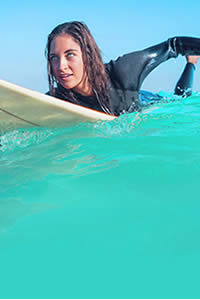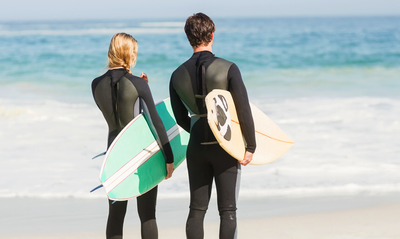A good wetsuit can save your life

A good wetsuit will make the time you spend in cold water so much more enjoyable and longer lasting, but a wetsuit isn’t just a wetsuit, so it is essential to know what you are looking for when it comes to buying the right wetsuit. Here is the ultimate wetsuit buying guide for those new to water sports, and even for the seasoned pros who wish to know which features to look for when buying their wetsuits.

Wetsuit
buying guide
Wetsuits are a key piece of equipment for anyone
wishing to engage in water sports. A good wetsuit will make the time you spend in cold water so much more enjoyable and longer lasting, but a wetsuit isn’t just a wetsuit, so it is essential to know what you are looking for when it comes to buying the right wetsuit. Here is the ultimate wetsuit buying guide for those new to water sports, and even for the seasoned pros who wish to know which features to look for when buying their wetsuits.

WHY
Do I Need a Wetsuit?
Whilst keeping warm is important, a wetsuit does far more for avid water sports fans.
Here are just some of the benefits to be gained from using a wetsuit:
Warmth
Buoyancy
Energy conservation
Speed
A wetsuit is very important when engaging in water sports, as it helps to keep you warm whilst in the water. Ensuring that you are always as warm as possible when in cold water such as when in the ocean can be the difference between life and death. Wetsuits are made out of neoprene, a synthetic rubber perfectly suited to keeping your body temperature at a well-maintained level.
Wetsuits help to maintain your body temperature by trapping a thin layer of water between your skin and the neoprene of the wetsuit. This layer of water is heated up by your body, which helps to maintain your overall body temperature. As wetsuits work by trapping a thin layer of water within the suit, it is absolutely essential to get a wetsuit that is tightly fitting and comfortable, otherwise the water within the suit will not heat up adequately to maintain your body temperature.

full wetsuit vs shorty wetsuit


A full length wetsuit covers the whole of your body, except for your head, hands, and feet. Full length wetsuits are used all year around, but vary in thickness depending on what time of year you are using one.
Full Wetsuits come in 2 or 3mm for the summer, right up to 6mm for the depths of winter. A shorty wetsuit naturally covers less of your body than a full length suit, with the neoprene fabric enclosing your torso, upper arms, and thighs, allowing for a greater flexibility in the movement of your arms and legs. Shorty wetsuits are more commonly used during the summer months, are 3/2mm in construction, have flatlocked seams and due to the reduced effectiveness of body temperature retention, it is highly unadvisable to use a shorty wetsuit during the winter.
size
The best size of wetsuit for you is dependent on your height and chest size. As already mentioned, a wetsuit works by trapping a thin layer of water close to your body, which is in turn heated up by your body temperature, achieving a good level of heat retention. For this reason, it is essential to make sure that you get the right size for your body. If the wetsuit does not fit your body closely enough, then all of the insulation will be lost.
Before purchasing a wetsuit, make sure to take note of your body measurements so that you can get a wetsuit that is perfectly fitted for your requirements.
Be aware that neoprene stretches significantly when wet, up to 50%. So when you try your suit on at home or in the shop, it needs to be extra tight!
thickness
Wetsuits typically come in thickness bands of 3/2mm, 4/3mm, 5/4mm, and 6/5mm. The larger number refers to the thickness of the neoprene fabric around your torso, whilst the smaller number refers to the thickness of the neoprene around your arms and legs. For example, the 5/4mm wetsuit would have a neoprene fabric thickness of 5mm around your torso, and 4mm around your arms and legs. Getting the right thickness for your wetsuit is essential to keep your body temperature at an acceptable level. Moreover, the thickness of wetsuit required is dependent on the temperature of the water, and so it is crucial to ensure that you are always informed of the temperature of the water you are about to enter.
As a general rule of thumb, for northern Europe, you would wear a 3/2mm suit from May till September. a 4/3 suit might be suitable from April till October and then a 5/4 or 5/3mm suit from October till May.


seam construction
When it comes to wetsuit seam construction there are many options to choose from, and it really is very important that you understand the different types, so you know which one is right for you.

Flatlock
Flatlock is is the most basic of stitching. The panels of neoprene are placed together and stitched over to create a flat, flexible and comfy seam. The seam is strong, but its not watertight or windproof. Water can pass back and forth through the seam (something called flushing). So the water trapped in the suit can escape before its warmed up. This stitching is only used on 3mm suits or thinner and is designed for use on suits used in the sumer.

Blindstitch
Blindstitching is the method used to completely strengthen & waterproof the seams in a wetsuit. The suit’s panels are glued and butted together and then stitched in a way that does not penetrate through to the inside. It is then further strengthened by heat welded tape being incorporated into the suit’s high stress seam areas.
The suit is then completely waterproof (except for getting in down your neck, arms or ankles). This method is used on some 3mm suits but predominantly on 4 or 5mm suits.

Liquidseam
In order to achieve a reinforced 100% water tight seal, the wetsuit’s panels are glued & blindstiched, with the seam being sealed using a coloured liquid silicon based urethane.
This doesnt make the suit more waterproof than a blindstitched suit, but it helps it last longer as the seams are reinforced. Recently this has kind of fallen out of favour with manufacturers and most suits now are just blind-stitched
A watertight seem prevents the warmed up water already inside the suit from escaping. When water escapes it is know as ‘flushing’, so a completely waterproof suit will dramatically reduce any flushing.

winter vs summer
As already mentioned, full length wetsuits are essential during the winter months, and shorty wetsuits are more popular during the summer. The time of year dictates what temperature the water will be, and the type of wetsuit you would wear is completely dependent on the temperature of the water you are going to enter.
Here is a quick guide to what kind of wetsuit and accessories you would need for different water temperatures:
winter
12 degrees centigrade
a 4mm full wetsuit is required, with the addition of wet boots optional
9 degrees centigrade
a 5mm full wetsuit is required, with wet boots required, and hood and gloves optional
6 degrees centigrade
a 6mm full wetsuit is required, with wet boots, hood, and gloves also required
summer
22 degrees centigrade
a wetsuit would not be needed in this temperature, and neither would any accessories
19 degrees centigrade
a 2mm, shorty wetsuit would be advised, with no accessories
15 degrees centigrade
a 3mm shorty or full wetsuit would be advised, with no accessories
To find your perfect wetsuit, why not browse the selection we have on offer here at Coast Water Sports.
All our brands have been handpicked to ensure we offer only the best wetsuits on the market.
If you’re intersted in learing more about wetsuits check out some of our other blog posts where we go in to even more detail on Wetsuits here



